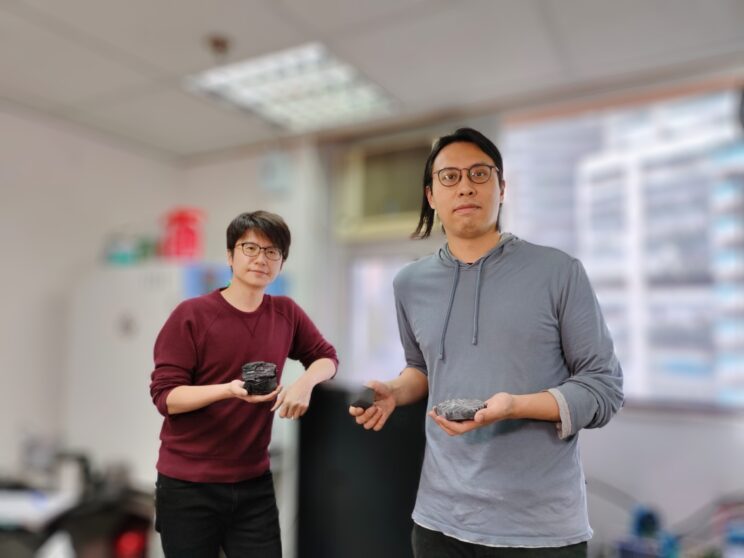CLS System Environmental Technologies

Carbon Lite System: Biomass Movement
Charcoal has been around for even longer than we have. As nothing more than carbonised wood, it is exceptionally easy to make and cheap to buy. It is everywhere in our world, and yet nowhere in our consciousness.
That may soon change, given a couple more breakthroughs from the partners in Carbon Lite System Environmental Technologies (CLS). Charcoal – or at least the sheer volume of it that goes to waste every day – is very much in their consciousness, and they are determined to find the key to a kind of alchemy; that is, the transformation of this cheap, readily available base material into a useful replacement for other, less environmentally friendly materials.
Converging interests
The partners in CLS are (CEO) Pirry Leung and (COO) Dr Oliver Yeung, who met years ago through their common interest in a somewhat different kind of alchemy. “I used to work at an organic waste treatment facility here in Hong Kong. At that time we saw a lot of food waste – waste that was still perfectly fresh, clean and edible,” Pirry recalls. “Space is at a premium in Hong Kong, so when new stock arrives, businesses like supermarkets, hotels, airline catering services, etc, will just discard the old stock – even if it is still good-as-new.”
Oliver meanwhile was researching methods on extracting nutrient protein from waste water, to be processed into pig feed. The pair’s mutual interest in taking biomass waste and increasing its value eventually led them to join forces – “He was always on the academic side, I was more on the application side,” notes Pirry. Their product was to be dog food, made largely from food ‘waste’ collected from various commercial kitchens.
The same basic thinking soon led them to the potential of charcoal and the development of the carbon lite system – the ‘CLS’ in their company’s name. But why charcoal?
Sparked by a BBQ
According to Pirry, their original inspiration was sparked by a barbeque in a friend’s garden. “Basically, we were producing charcoal in an oil drum, and by cooking on it we were using the waste heat. This started us wondering about biochar.”
From that, one must consider the big picture: Hong Kong, like many other places, generates mind-boggling amounts of biomass waste (mostly food and wood) every year – about 11.2 billion tons globally per year. In Hong Kong’s case, just five percent is recycled. The rest is left to decay, one way or another, producing greenhouse gases and polluting the air, soil and water.
Some of this biomass is converted into a type of charcoal called biochar, which is most commonly used for soil amendment and has some applications as an absorbent. However, demand for biochar falls far short of consuming the potential supply. This is where carbon lite comes in. A proprietary process, carbon lite heats biomass or biochar to over 3,000 degrees Celsius, creating yet another material – graphene – in less than 30 seconds.
Exploring untapped potential
As Pirry explains, graphene has very different qualities to its progenitors, giving it a whole range of new and potentially valuable applications. “We basically use it as an electrically conductive coating that can be applied to microelectronics. It could also replace the graphite that is 18-20% of the content of all batteries.”
Graphene can also be mixed into other substances to give them conductive properties. In that vein, Pirry suggests it as an alternative to carbon black, a commonly used conductive paste that is a byproduct of petroleum production. Conductive de-icing concrete – currently made with relatively expensive graphite – could be produced more cheaply with graphene made with CLS’s process.
As well as graphene, CLS is also exploring ways to expand the use of biochar itself. Biochar pebbles, for example, could replace heavier conventional aggregate to make concrete. In this case, says Pirry, the barriers to wide usage aren’t technical, but financial: “Concrete is very cheap, so competing against its price is a problem. Building codes also take a long time to change.”
As a building material, tiles or plaster made from biochar may have greater potential. “They work as a kind of thermal insulation, so they can help buildings stay warmer in the winter and cooler in summer,” Pirry explains. Indeed, the company has embarked on trial applications for just these materials with Hip Hing Construction and New World China.
Even more potential partners and investors have been explored since CLS’s introduction to InvestHK during a business matching session at the StartmeupHK Festival 2023. Through InvestHK, the company also received a useful promotional boost, spurring further interest in their ideas.
After the breakthrough
Ultimately, having developed their biochar ‘killer app’, Pirry and partner see their company as selling the technologies of the process to waste management companies, who could operate the machinery themselves. “They could produce graphene powder and send it to us, and we would then apply it to polymers, concrete or whatever materials to make it conductive,” says Pirry. CLS has leapt many hurdles in a short time to achieve all these goals.


